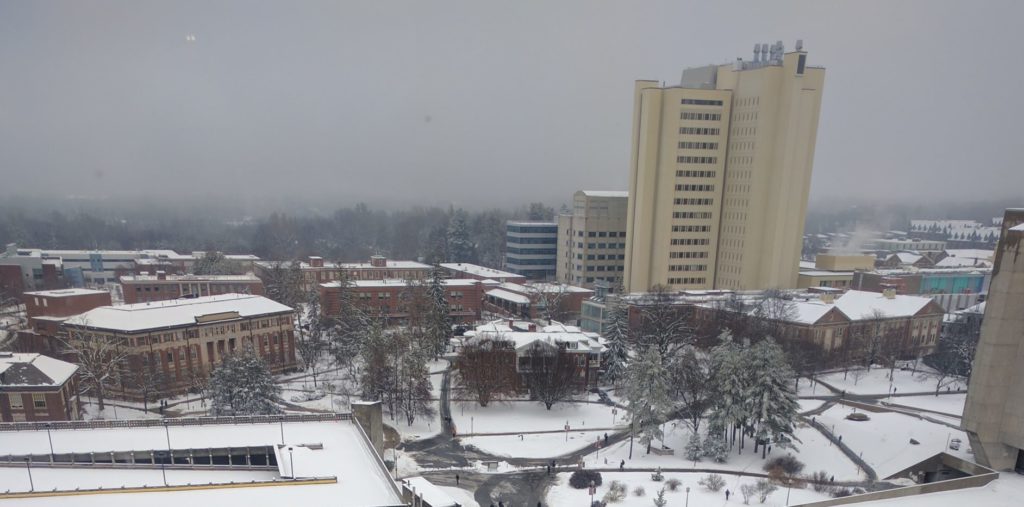UMass-Amherst Logs Over 400 Active COVID-19 Cases Within Days Of Reopening, Imposes New Restrictions

The UMass-Amherst campus as seen from the library in winter. Source: Wikimedia Commons
All Students On And Off-Campus Directed To “Self-Sequester”
Just six days into the official start of the spring semester, UMass-Amherst has shifted entirely to remote instruction, and directed all students to “self-sequester.”
COVID-19 cases at UMass have risen rapidly over the last few days. The UMass COVID-19 Dashboard showed 445 “active” cases as of 4:30 PM on Sunday (2/7) although later in the evening, the active case number was revised downward to 424. Available isolation space, for those who have tested positive, was listed at 63.8% capacity.
The surge comes amid reports of indoor parties where students gathered unmasked.
“Contact tracing data indicates that transmission of the virus is especially prevalent among some undergraduate students not following social distancing and mask protocols,” wrote UMass Chancellor Kumble R. Subbaswamy in a statement released on Sunday. He expressed appreciation for “the vast majority of students who are complying with public health protocols.”
It is unknown how many of the current cases are symptomatic. UMass has a large asymptomatic testing program, and is requiring all students to be tested twice a week. UMass administered an all-time high of 4,302 COVID-19 tests on February 4.
The campus’ COVID-19 risk level was raised to “high” on Sunday afternoon, just two days after UMass shifted its operational stance from “guarded” to “elevated.” Beginning at 2 PM on Sunday, all students both on and off campus were directed to stay in their residences except to get meals, undergo twice-weekly COVID-19 testing, or for medical appointments, Subbaswamy stated. The new restrictions will be in place for at least 14 days, and “will only be lifted when public health conditions improve substantially.”
Failure to comply with the directives is a violation of the Code of Student Conduct, Subbaswamy wrote, and “will result in disciplinary action, which may include removal from residence halls and/or suspension.”
“To many of you, these may seem like drastic measures, but faced with the surge in cases we are experiencing … we have no choice but to take these steps. By acting aggressively now, we are confident we can contain this surge, and more quickly return to normal operations,” he wrote.
Sports practices have been cancelled, and students were told they should “refrain from travel from campus or outside the surrounding area.”
About 5,400 UMass students were slated to be on-campus for the semester beginning February 1, and 7,000 to 8,000 off-campus. Those invited to live on campus included undergraduates enrolled in mandatory face-to-face classes or athletics, first-year students and new transfers. A phased return and move-in took place from January 25 to 31. Dorms were expected to be at 39% capacity, UMass officials said.
Students were directed to get tested when they arrived, and to observe a “modified quarantine” and avoid interactions until they had gotten two negative COVID-19 tests. It was unknown on Sunday whether some students managed to evade those testing requirements.
The UMass COVID-19 Dashboard shows that there have been a total of 1,262 COVID-19 cases in the UMass community since August, with 862 among off-campus students, 275 on-campus, and 125 among faculty and staff. UMass has conducted 241,856 tests, with a seven-day cumulative positivity rate of 2.13%.
As of Friday. Feb. 5, the Town of Amherst logged 324 “active” cases, for a cumulative total of 1,363 since the pandemic began.
UMass students are required to follow the university’s Interim Pandemic Policy, and gatherings of more than five people require pre-approval by the UMass Environmental Health & Safety Office.
“Let this moment be a stark reminder to any of you who may have been cavalier about COVID-19 that your individual behavior has a profound impact on everyone in your community,” Subbaswamy wrote.

I think the Chancellor should make the case to the Governor to let them vaccinate all the students while they’re in lock down . We would all benefit.
What about offering to vaccinate all faculty and staff as well?
Or all students and staff in our public schools?
In this vein, please see this most-recommended NYTimes comment (by a high school student) as of last night:
https://www.nytimes.com/2021/02/11/upshot/schools-reopening-coronavirus-experts.html?campaign_id=57&emc=edit_ne_20210212&instance_id=27089&nl=evening-briefing®i_id=55139425&segment_id=51577&te=1&user_id=385a4868630e6bb960e8a4c8cd900028#commentsContainer
Comments 819SKIP TO COMMENTS
The comments section is closed. To submit a letter to the editor for
publication, write to letters@nytimes.com.
NYT PicksReader PicksAll
Naima commented February 12
N
Naima
Pittsburgh
Feb. 12
Times Pick
“Most important, they said, were universal masking, physical
distancing, adequate ventilation and avoidance of large group
activities.”
This is a BIG asterisk that is only mentioned in passing, but is
completely unrealistic. I’m a high school student and attend a
combined middle school/high school. The school itself is ancient, has
little to no ventilation, and narrow hallways. Furthermore, we’re
students: I’ve seen dozens of people take off their masks or wear them
improperly, not respect social distancing, or gather in large groups
to play. As far as I’m concerned, while the negative impact on
education is significant, so are teachers’ lives. While the article
may state that community transmission effects are quite low, the risk
to specific teachers is much higher and dozens have actually died.
It’s sad to see people in the comments accuse teachers of being
selfish/not caring, when teaching is a profession that already doesn’t
pay enough and is very much a passion based job. Forcing them to put
themselves at risk (in worse conditions than many other “essential”
workers due to the lack of safety measures, I might add) is not at all
ethical. As a student, while I’d love to have in person classes, I
respect that my teachers’ safety is vital. So yes, your child’s
learning might be affected, but that does not necessarily outweigh
teachers’ lives. Both sides have valid points, but I firmly support
closing schools until teacher vaccination is possible
14 Replies375 RecommendedShare